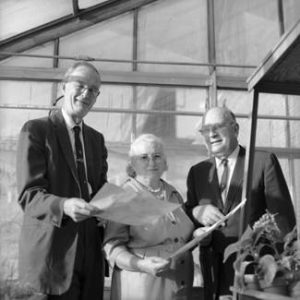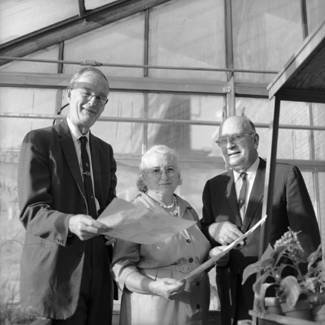(August 1, 1899 – May 28, 1992)
Q21509924
The University of North Carolina at Chapel Hil Herbarium (NCU) has cataloged approximately 40 specimens collected by Hannibal Albert Davis and his spouse, Tyreeca Stemple Davis. No doubt more will be found as cataloging continues. The Davises usually signed their specimens “Mr. and Mrs. H.A. Davis.” The Davises collected many specimens for distribution in the Southern Appalachian Botanical Club’s series of exsiccati.

Hannibal Albert Davis was born in Marshall County, West Virginia. He earned both A. B. and M.A. degrees in mathematics from West Virginia University. Upon completion of Ph.D. in mathematics from Cornell University in 1928, he joined the mathematics faculty West Virginia University in Morgantown, WV, and served as that department’s head from 1948-1960. Upon retirement, the Davises moved to Freeport, Florida (ca. 1982).
Davis’ botanical interests included Rubus and Viola. Rubus leggii was named by H. A. and Tyreeca Davis in William Clarence Legg’s honor (Davis, H.A. and Tyreeca Davis. 1953. The genus Rubus in West Virginia. CASTANEA 18(1): 1-31). “This species is dedicated to the memory of the late William C. Legg, naturalist of Mount Lookout, Nicholas County, West Virginia, whom we accompanied on several pleasant and profitable field trips” (p. 27-28).
The Harvard Herbaria Database lists CM (Carnegie Museum of Natural History in Pittsburgh, Pennsylvania, USA) as a major repository for Davis’ herbarium specimens, though it seems likely that WVA (West Virginia University in Morgantown, WV, USA) would have many as well.
Dr. Wayne Davis and Dr. Elizabeth Davis Swiger established the H.A. and Tyreeca Davis Herbarium Endowment at WVA in honor and memory of their parents.
Anonymous (1988) Davis Herbarium Goes to Carnegie Museum. CASTANEA 53: 83.
The private herbarium of Hannibal A. and Tyrecca E. Davis has been given to the Carnegie Museum in Pittsburgh. This consists of a 10,000 sheet general collection with emphasis on West Virginia, and 10,000 sheets of Rubus, mostly from eastern North America. The Rubus material is the basis for the Davis’ (with A. M. Fuller) revision of the North American Eubati (Castanea 1967, 32: 20-37; 1968, 33:50-76; 1969, 34: 157-179; 1969, 34: 235-266; 1970, 35: 176-194; 1982, 47: 216-219). Although it contains no types, this is the most valuable collection extant to use in identifying an unknown specimen. For each species the Davises had a “working type”, usually from the type locality or nearby, which they had carefully compared to the type specimen. For many species names the type is too poor to be recognizable: too immature; floricanes only; primocanes only; parcifronds or novirames; a mixture of more than one species, or other such problems. With considerable effort, often observing at different stages of development and sometimes growing the plants, they were able to prepare good material that they were confident represented the species described.
The Davises visited most of the type localities for North American Rubus names, and their collection contains representatives for nearly all names.
All the Davises’ working materials regarding Rubus (notes made when examining types, manuscripts, correspondence, annotated reprints, etc.) have also been deposited at the Herbarium of the Carnegie Museum.
Partial list of publications:
Davis, Hannibal Albert (1930) Involutorial transformations belonging to a linear complex. Am. J. of Mathematics 52(1): 53-71.
Davis, H.A. and Tyreeca Davis (1953) The genus Rubus in West Virginia. Castanea 18 (1): 1-31.
Core, Earl L. and H.A. Davis (1953) New plant records for West Virginia. Castanea 18 (1): 31.
Davis, H.A., Albert M. Fuller, and Tyreeca Davis (1982) Some comments on Rubus. Castanea 47 (2): 216-219.
Davis, Hannibal A. (1990) Studies in “Rubus.” Castanea 55 (1): 22-30.
